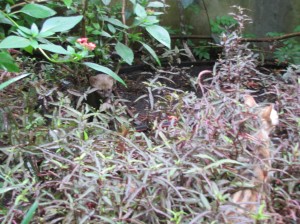
Entrance painted by volunteers, Paradise Gardens Wildlife Rescue, Boquete, Panama
In 2002 Paul and Jenny Saban retired to Boquete, Panama from England with their pet cockatoo, Sam, two pet green winged macaws named Dollar and Ruby, a pair of Australian leadbeaters, a pair of Hyacinth Macaws and a pair of pair of pink galahs. Paul and Jenny had been breeders of rare tropical birds in the UK so the birds they had were in breeding pairs except for Sam, the cockatoo. In order to legally import and keep these birds Paul and Jenny applied for a license from ANAM, the Panamanian agency in charge of wildlife and the environment. ANAM was one of the first agencies to agree to the international CITES agreement which control the trading of rare birds in order to prevent poaching and their decline in the wild. Once licensed and living here Paul and Jenny began to convert the orange orchard they were living on into an amazing garden sanctuary for their own birds. Paul, a master stone mason, began work on paths and fountains while Jenny, an avid gardener, brought to life a true paradise of native trees, flowers and bushes. They both had experience in creating gardens in the UK and put there expertise to use here in Boquete, Panama
At the time Panama was lacking in wildlife rescue and rehab centers. Paul and Jenny began to take in birds that had been injured and rehab them. ANAM saw the wonderful work they did and the spaces available for the birds at Paul and Jenny’s and asked them to take in a few more injured birds from the local area. They accepted and built more large cages for scarlet macaws, and hyacinth macaws and a large aviary for smaller birds.
Soon word spread that Paul and Jenny were experts at caring for injured birds and local residents began bringing in other animals… a tiny tamarind that had been separated from his mother, an injured sloth, an ocelot cub too young to survive on its own but too big to stay in their house. Soon Paul and Jenny had a whole garden filled with an ark of different species.
Unfortunately all these animals were expensive to keep. There was the bird seeds, the fruits and nuts and eggs and meat, as well as live mice and chicks for the big cats. And for the animals that arrived due to injury there were the vet bills and the medicines and bandages and syringes (have you ever tried to give a shot to a capuchin monkey? Me neither, but I can only imagine, I mean they’ll steal your glasses off your face and then pee on your head, what would it take to get a needle close to them?!). As retirees Paul and Jenny’s funds were finite and would not infinitely expand to support the influx of animals. So they opened their home to the public, asking for 5 dollars as a entrance fee and any donations that visitors could give. The beautiful grounds earned the name Paradise Gardens. The rehabilitation and release of wild animals has always been the primary goal of Paradise Gardens. We specialize in animals native to the Boquete, Panama area but also take in animals from Bocas del Toro, the Darien and all over Panama.
Two years ago in 2008 Paul and Jenny were involved in a serious car accident. They were forced to return to England with almost no notice and have been unable to return since. The animals, of course, could not leave the country with such short notice. They stayed behind in enclosures and were taken care of by friends and neighbors, volunteers.
With Paul and Jenny back in England for what looked like a permanent stay the property was on the market. The gardens continue functioning supported completely by volunteers who care for the animals and the grounds and donations which cover food and medical expenses for the animals. Several people have come to look at the property but the fact that it is set up as an animal rescue will require a very special buyer with the patience and funds to support the constant in and outflow of animals.







